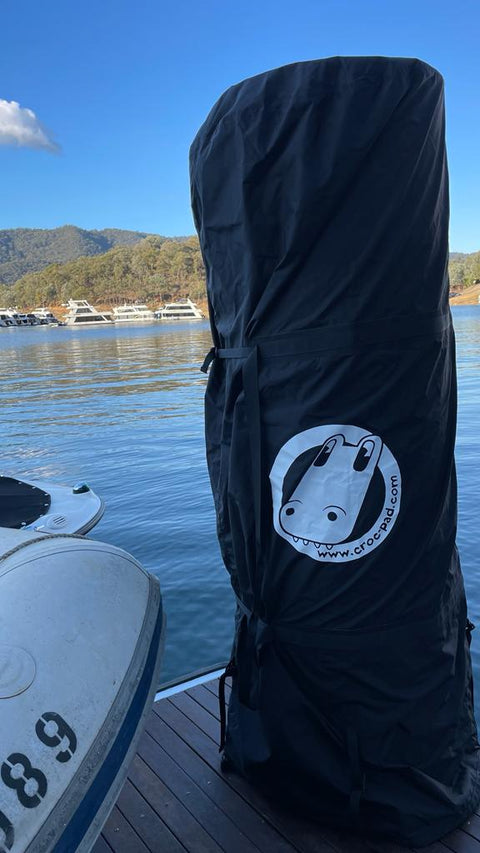Owning a floating water mat is a fantastic way to enjoy fun and relaxation on the water. Whether it’s a day at the lake with family or lounging in the pool with friends, these mats offer endless enjoyment. However, like any recreational equipment, proper care is essential to keep your water mat in top shape for the long term. A key part of this care involves regularly cleaning the mat and storing it in a weatherproof storage bag. Here’s why these steps are crucial to maintaining the quality and longevity of your floating water mat.
Why Regular Cleaning is Important
After a fun day on the water, your mat may collect dirt, sand, algae, and even sunscreen residue. If left untreated, these elements can wear down the mat’s material over time, shortening its lifespan. Regular cleaning is not only about keeping your mat looking good, but also about maintaining its performance and durability.
-
Protect the Material: Over time, dirt and other residues can degrade the surface of the mat. Cleaning helps preserve the integrity of the material, ensuring it stays strong and buoyant for future use.
-
Prevent Mold and Mildew: If you store your mat while it's still wet or dirty, you risk promoting mold and mildew growth. Mold not only looks unsightly and smells bad, but it can also weaken the material. Cleaning and drying the mat after each use prevents this problem.
-
Extend the Life of Your Mat: Consistent cleaning is an easy way to protect your investment. By removing harmful substances from the surface, you help ensure that your mat stays in great condition season after season.
-
Safety Concerns: A clean mat is a safer mat. Dirt and grime can create a slippery surface, which could cause falls, especially for kids and pets. Keeping the mat clean helps provide a safer space for everyone to enjoy.
Steps for Proper Cleaning
Cleaning your floating water mat is simple and doesn’t take much time. Here’s how to do it right:
-
Rinse After Each Use: Use fresh water to rinse off any dirt, sand, salt, or chlorine after a day on the water. This helps prevent buildup that could damage the mat.
-
Use a Mild Detergent: For a deeper clean, mix a mild soap with water and gently scrub the surface using a sponge or soft brush. This helps remove oils and other stubborn substances without damaging the material.
-
Air Dry: After cleaning, let the mat air dry completely in a shaded area. This step is crucial to avoid any moisture-related issues, like mold or mildew, when the mat is stored.
The Importance of Proper Storage
Once your floating water mat is clean and dry, proper storage becomes the next important step. Storing the mat in a weatherproof storage bag protects it from environmental damage, helping maintain its quality when not in use. Here’s why it’s worth the extra effort:
-
Protection from the Elements: Sun, rain, and extreme temperatures can all take a toll on your water mat if it’s left exposed. Over time, UV rays can fade the mat’s color and weaken its material, while rain or snow can lead to cracking or mold growth. A weatherproof storage bag provides a reliable shield against these harsh conditions.
-
Minimize Wear and Tear: Storing your mat improperly can lead to accidental damage, such as punctures, abrasions, or folds that weaken the material. A storage bag keeps the mat secure and protected from these kinds of risks, ensuring it’s ready for use the next time you’re heading out to the water.
-
Moisture Control: One of the biggest concerns with storing a water mat is preventing moisture from getting trapped inside, which can lead to mold and mildew. A weatherproof storage bag, combined with proper drying before storage, helps keep your mat free from moisture-related damage.
-
Convenient Storage Solution: Not only does a storage bag protect your mat, but it also helps keep it organized. Rolling or folding the mat into a bag makes it easy to transport and store without taking up too much space.
How to Store Your Floating Water Mat
Proper storage is simple but vital to maintaining the mat’s quality. Here’s how to store it correctly:
-
Clean and Dry the Mat: Always ensure the mat is clean and completely dry before putting it away. Even a little moisture left on the mat can lead to problems like mold during storage.
-
Roll or Fold the Mat: Depending on the size of your mat, you can either roll it or fold it neatly for storage. Be careful not to create any sharp folds that could damage the material.
-
Use a Weatherproof Storage Bag: Once the mat is folded or rolled, place it inside a weatherproof storage bag. The bag will protect the mat from moisture, sunlight, and other environmental factors that could cause damage.
-
Store in a Cool, Dry Location: When not in use, store the bag in a shaded, cool, and dry place—like a garage or storage shed. Avoid exposing the mat to extreme temperatures, which could affect its material even when stored in a bag.
The Benefits of a Weatherproof Storage Bag
A weatherproof storage bag is an essential accessory for anyone looking to preserve their floating water mat. These bags are designed to withstand outdoor conditions, providing superior protection against moisture, dirt, and UV exposure. Investing in a high-quality storage bag is a smart move if you want to maximize the lifespan of your mat and ensure it stays in great condition.
Conclusion
Cleaning and storing your floating water mat properly is essential to maintaining its durability and functionality over time. Regular cleaning helps prevent material breakdown and keeps the mat safe to use, while storing it in a weatherproof bag protects it from the elements and accidental damage. By following these simple steps, you can enjoy your water mat for many seasons to come, ensuring fun and relaxation on the water whenever you need it.



